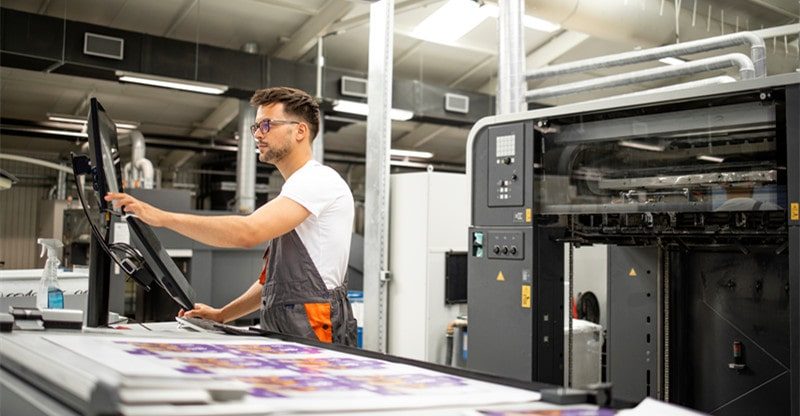Implementing Ultrastream in Printing Workflows: Challenges and Solutions
This article will look into the significant role of Ultrastream technology in influencing and shaping trends within the printing industry. Ultrastream, a cutting-edge inkjet technology, has the potential to revolutionize printing workflows by delivering higher-quality prints at faster speeds and lower costs.
The remarkable precision of Ultrastream’s print heads ensures sharp images and clear text on printed materials, captivating consumers with its vibrant graphics and lifelike representations. You can download the white paper for your business to explore the in-depth advantages and applications of Ultrastream Printing.
Moreover, Ultrastream’s eco-friendly ink formulations derived from bio-based sources align perfectly with the growing demand for sustainable printing practices, resonating with environmentally conscious consumers. As manufacturers optimize production processes, Ultrastream Printing has the potential to strike the ideal balance between cost-effectiveness and exceptional print quality, further enhancing its appeal to businesses and consumers alike.
The Promise of Ultrastream Technology
Ultrastream technology has garnered significant attention within the printing industry due to its potential to elevate printing capabilities to new heights. Its promise lies in its ability to achieve ultra-high resolutions, produce vibrant colors, and deliver unmatched printing speed. This cutting-edge technology enables printing companies to meet the growing demand for high-quality prints in various applications, from commercial printing to packaging.
The Ultrastream technology boasts remarkable advancements in print head design, ink formulations, and data processing capabilities, making it a game-changer for the industry. With its precise drop placement, Ultrastream can achieve up to 1200 dpi resolutions, ensuring crisp and sharp images. The technology’s high-speed capability also enables printing at up to 150 meters per minute, dramatically reducing production time and increasing efficiency.
Compatibility and Integration Issues
One of the initial challenges printing companies face when adopting Ultrastream technology is ensuring compatibility with their existing printing systems. Integrating a new technology seamlessly into an established workflow can be daunting, often requiring software and hardware updates.
For instance, printing companies may encounter compatibility issues with their color management software when implementing Ultrastream, necessitating adjustments to the existing color management system.
To address these challenges, collaboration with technology providers is crucial. Ultrastream manufacturers often offer comprehensive integration support, assisting printing companies in identifying potential compatibility issues and finding suitable solutions. Close cooperation with expert teams can streamline the integration process, minimizing disruptions and maximizing the benefits of the technology.
Investment Costs and ROI
Implementing Ultrastream technology requires a considerable investment, including acquiring new printers and upgrading infrastructure. The initial cost of adopting this cutting-edge technology can be a significant barrier for many printing companies. As a result, careful financial planning is essential to ensure a positive return on investment (ROI).
Printing companies need to consider multiple factors to evaluate the ROI of adopting Ultrastream technology. These include projected increases in production capacity, reduced material costs due to higher print quality and reduced ink consumption, and the potential for attracting new clients seeking premium print services.
By conducting a thorough cost-benefit analysis, printing companies can make informed decisions and justify the initial investment in Ultrastream technology.
Training and Skill Development
The successful implementation of Ultrastream technology relies on advanced equipment and skilled operators who can fully utilize the technology’s potential. Printing companies must invest in training programs to equip their staff with the necessary expertise. This includes understanding the intricacies of the technology, troubleshooting common issues, and maximizing productivity through efficient workflow management.
Training programs can be tailored to meet the specific needs of printing companies. Hands-on workshops, online courses, and collaboration with technology providers’ training teams can empower operators with in-depth knowledge and practical experience. By investing in continuous skill development, printing companies can ensure their workforce is well-prepared to handle Ultrastream technology and capitalize on its capabilities.
Maintenance and Support
As with any sophisticated technology, Ultrastream requires regular maintenance to ensure optimal performance. Printing companies need access to reliable technical support to address any unexpected challenges promptly. A dedicated support team from the technology provider is crucial to quickly resolving issues, minimizing disruptions, and meeting customer deadlines.
In addition to on-call technical support, printing companies can benefit from preventive maintenance programs offered by technology providers. These programs include regular system check-ups, software updates, and calibration services to ensure the printer performs at its peak. Timely maintenance can prevent potential issues and extend the lifespan of the Ultrastream technology.
Print Quality and Color Consistency
Ultrastream technology promises superior print quality and color accuracy, but achieving consistent results can be challenging. Substrate variations, environmental conditions, and ink interactions can impact color fidelity. To maintain consistent color output across different printing jobs, rigorous color profiling and calibrations are necessary. Collaboration with the technology provider can help fine-tune workflows and ensure color consistency.
Advanced color management solutions are pivotal in achieving consistent and accurate colors with Ultrastream technology. Companies can invest in spectrophotometers and color management software that enable precise color measurement and profiling. Regular calibration of the printing system, coupled with periodic color checks, ensures that print quality remains consistent throughout different print runs.
Workflow Optimization
Integrating Ultrastream into printing workflows requires careful optimization to maximize its benefits fully. Printing companies must streamline their processes to accommodate the technology’s higher printing speeds and rapid data processing capabilities. Restructuring workflows and integrating automation wherever possible can enhance efficiency and reduce human error.
Workflow optimization involves analyzing every printing process step and identifying improvement areas. Printing companies can reduce manual intervention and potential errors by automating tasks like file processing, job submission, and data handling. Additionally, optimizing the order of print jobs and scheduling can further improve throughput and minimize downtime between print runs.
Meeting Market Demands and Deadlines
As the printing industry becomes more competitive, meeting market demands and tight deadlines is crucial. The opportunity to download the white paper for your business is a valuable resource in understanding the nuances of Ultrastream integration, enabling businesses to thrive in an increasingly competitive landscape.
Implementing Ultrastream technology must not lead to delays or compromise on print quality. Thorough planning and coordination are essential to ensure a smooth transition. Adapting to the technology while keeping up with customer demands requires strategic foresight and efficient resource allocation.
Printing companies can adopt agile and flexible production strategies to meet market demands and deadlines. This includes maintaining an optimal inventory of printing materials, collaborating with clients to optimize project timelines, and leveraging Ultrastream technology’s high-speed capabilities for quick turnarounds. Printing companies can retain their competitive edge and enhance customer satisfaction by staying proactive and responsive to market demands.
Conclusion
Implementing Ultrastream technology in printing workflows presents a transformative opportunity for the printing industry. The promise of high-quality prints, faster speeds, and lower costs makes Ultrastream a game-changer. However, the journey towards successful integration comes with its share of challenges. Collaboration with technology providers, comprehensive training programs, and advanced color management solutions are key strategies to overcome these challenges.
You can download the white paper for your business to gain deeper insights into the best practices and strategies for seamlessly integrating Ultrastream technology into your printing processes. Investing in long-term planning and building a robust support infrastructure ensures a smooth and efficient adoption of Ultrastream technology.
As the printing industry continues to embrace the potential of Ultrastream, it is poised for a vibrant future, where innovation and efficiency propel it to new heights. By leveraging innovative solutions and learning from real-life experiences, printing companies can unlock the full potential of Ultrastream technology and remain at the forefront of the printing industry’s evolution.



